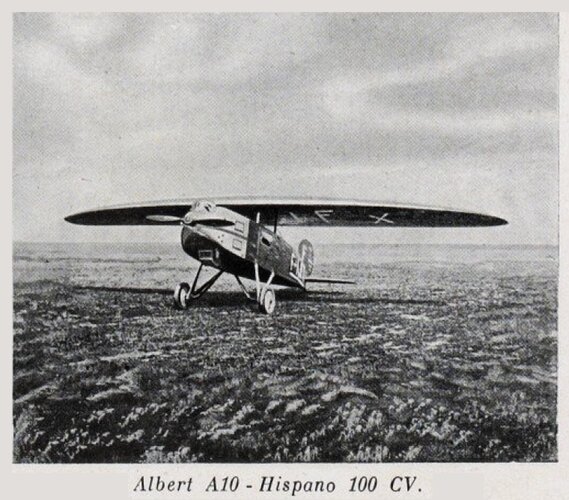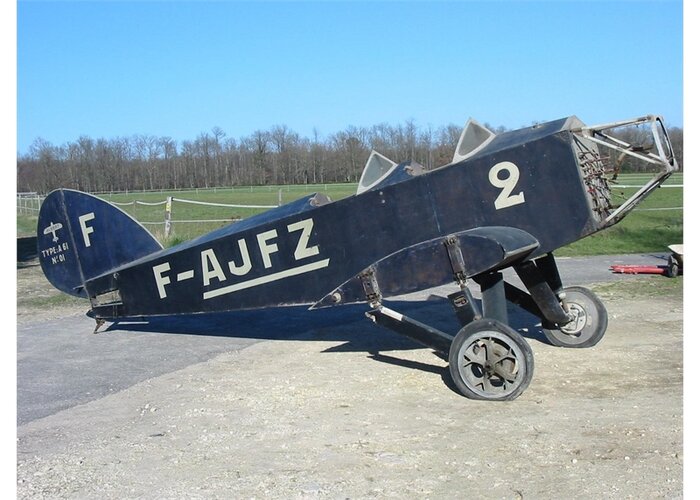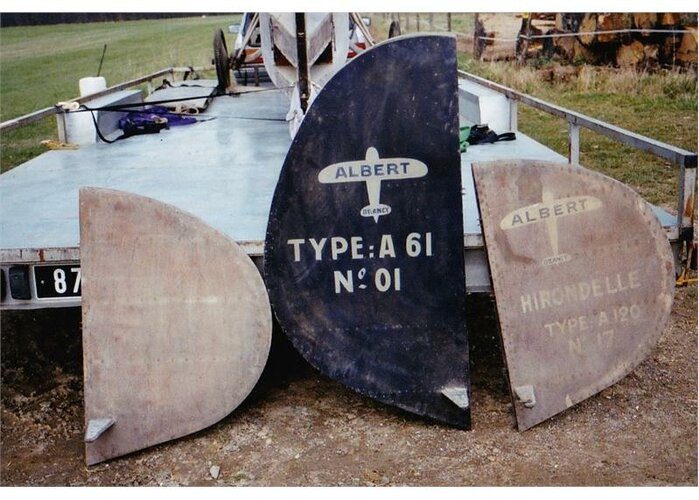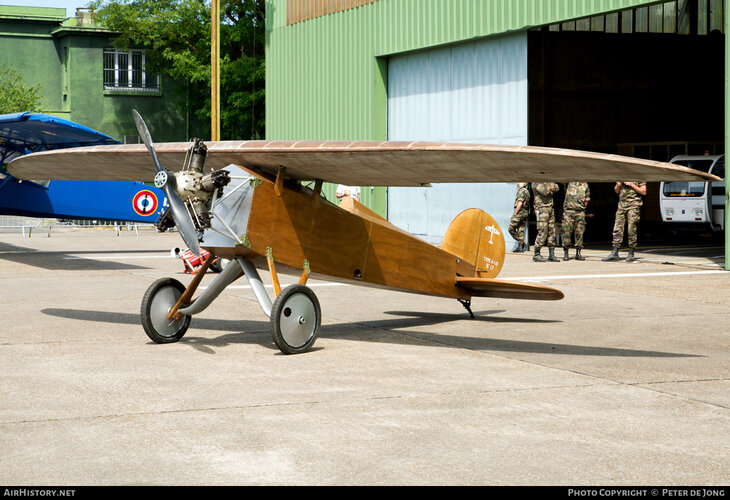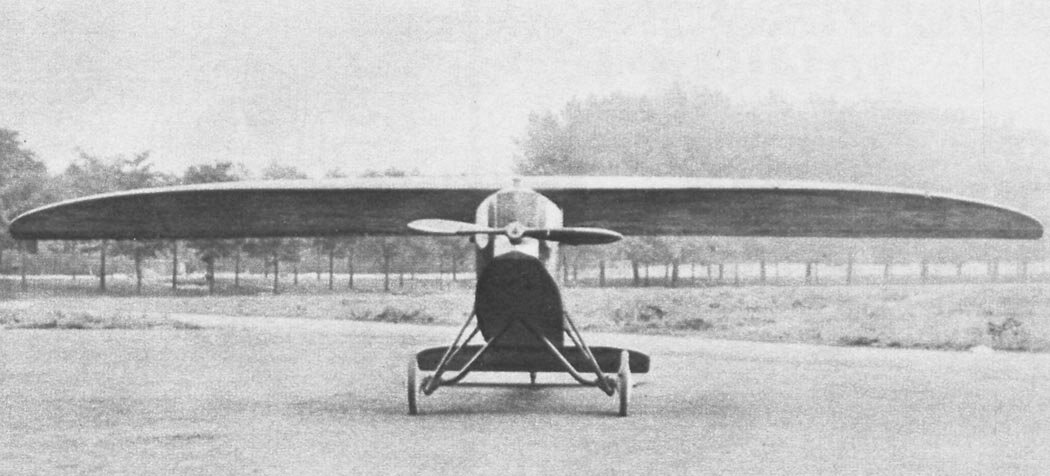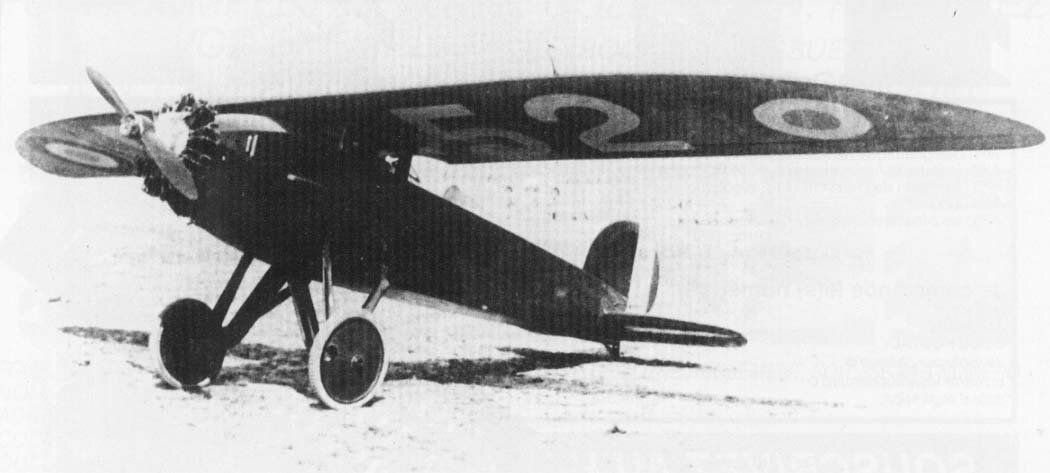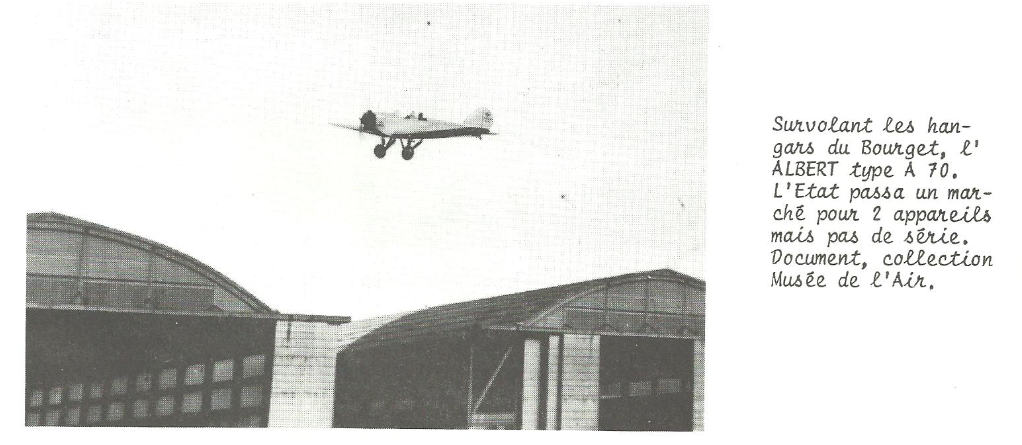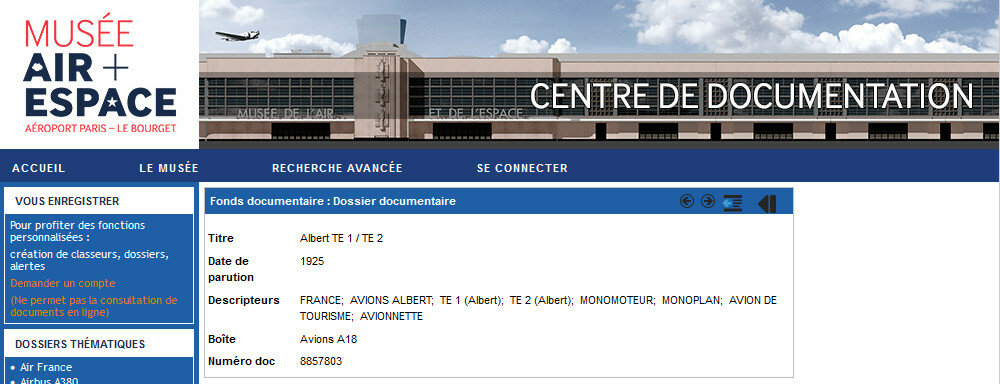You are using an out of date browser. It may not display this or other websites correctly.
You should upgrade or use an alternative browser.
You should upgrade or use an alternative browser.
Edouard Albert Designs and Projects
- Thread starter hesham
- Start date
- Joined
- 26 May 2006
- Messages
- 33,572
- Reaction score
- 13,701
Hi,
the Edouard Albert designed a beautiful twin boom low wing fighter project
and powered by two (push & pull) 500 or 550 hp engines.
http://www.flightglobal.com/PDFArchive/View/1938/1938%20-%202350.html
the Edouard Albert designed a beautiful twin boom low wing fighter project
and powered by two (push & pull) 500 or 550 hp engines.
http://www.flightglobal.com/PDFArchive/View/1938/1938%20-%202350.html
Attachments
Tophe
ACCESS: Top Secret
I do like it, thanks.
I had heard of the "Albert bifuselage" in Aviation Magazine #478 as after 1933 and well before 1940, without a drawing. Your source is far richer, for this 1936 project, with an unusual reason to be a twin-boomer: push-pull engines with one of the propeller used as brake in dive-bombing. Unusual.
I had heard of the "Albert bifuselage" in Aviation Magazine #478 as after 1933 and well before 1940, without a drawing. Your source is far richer, for this 1936 project, with an unusual reason to be a twin-boomer: push-pull engines with one of the propeller used as brake in dive-bombing. Unusual.
- Joined
- 25 June 2009
- Messages
- 14,141
- Reaction score
- 4,333
- Joined
- 25 June 2009
- Messages
- 14,141
- Reaction score
- 4,333
(translated and adapted from the French Wikipedia)
Edouard Albert was a French licensed touring pilot and the nephew of Alphonse Tellier, whose seaplanes were famous during the First World War.
Albert commissioned engineer Albert Duhamel to study a touring monoplane designated TE-1 as a tribute to Tellier, then went on to create the Société Anonyme des Avions Albert (which translates as Albert Aeroplanes, Ltd.). The firm developed a handful of touring aircraft as well as a low-wing monoplane for the Coupe Deutsch de la Meurthe before fading from sight in 1934.
Edouard Albert was a French licensed touring pilot and the nephew of Alphonse Tellier, whose seaplanes were famous during the First World War.
Albert commissioned engineer Albert Duhamel to study a touring monoplane designated TE-1 as a tribute to Tellier, then went on to create the Société Anonyme des Avions Albert (which translates as Albert Aeroplanes, Ltd.). The firm developed a handful of touring aircraft as well as a low-wing monoplane for the Coupe Deutsch de la Meurthe before fading from sight in 1934.
- Albert TE-1 : Single-seat touring monoplane with high cantilever wing and wooden undercarriage. Only one prototype was built [F-AIVA]. It could reach 150 km/h in 1926 with a radial 40 hp Salmson 9Ad engine.
- Albert A-10 : Four-seat parasol monoplane transport with a 100 hp Hispano-Suiza 6Pa engine. Only one example built [F-AJFX], which first flew on July 10, 1929.
- Albert A-20 : Two-seat high-wing monoplane mail aircraft with conventional undercarriage, which first flew on November 21, 1929. Being underpowered with its two 60 hp Walter engines, it was quickly refitted with 80 hp Armstrong Siddeley Genet engines, but arose no interest and was never even registered.
- Albert A-60 : This tandem-seater touring aircraft with open cockpits was similar to many comparable types of its time. It was a low wing monoplane with conventional undercarriage covered with wheelpants. Powered by a neatly-cowled 70 hp radial Walter Nz 70 engine — with only the cylinder caps protruding — it could reach 172 km/h with a 1000 km range. Only one example was built [F-AJFY].
- Albert 140: Low-wing monoplane racer with conventional undercarriage, designed for participation in the 1933 edition of the Coupe Deutsch de la Meurthe and powered by a 220 hp Régnier R-6 engine. Only one was built.
It sounds like it's time for an Albert designations thread. Pics of the TE.1 and A.20 are available at http://www.aviastar.org/air/france/a_albert.php and more info and pics of other models at http://www.aviafrance.com/constructeur.php?ID_CONSTRUCTEUR=78. Unfortunately the Aviafrance site is currently down. Too bad about the A.20, it was a neat little twin and might have found a useful nice if it could maintain altitude one one engine with the Genet (unlikely). Those signature Albert wings with the eliptical leading edge and straight trailing edge on various models sure are pretty.
- Joined
- 25 June 2009
- Messages
- 14,141
- Reaction score
- 4,333
cluttonfred said:It sounds like it's time for an Albert designations thread.
Actually I nearly moved this whole topic to the Designations section yesterday. It's clearly a problem with those minor companies to clearly separate the designations thread and projects thread...
- Joined
- 26 May 2006
- Messages
- 33,572
- Reaction score
- 13,701
Hi,
anther article about Albert push-pull twin boom fighter project,from Ailes;
http://gallica.bnf.fr/ark:/12148/bpt6k6555898t/f8.image
anther article about Albert push-pull twin boom fighter project,from Ailes;
http://gallica.bnf.fr/ark:/12148/bpt6k6555898t/f8.image
Attachments
- Joined
- 26 May 2006
- Messages
- 33,572
- Reaction score
- 13,701
Via dear Woodville,and from TU159,a two Projects
Studied to cover a distance of 1500 km. the type A.140RV intended for the Deutsch Cup 1933 had a wing with a dihedral of 6 °. The ailerons that fitted the full span could be used as curvature flaps. This was the last real achievement of the Albert company.
At the time of the 1934 Salon, it is mentioned that Mr. Albert was studying two new projects that we can suppose to be those mentioned in our initial study devoted to this builder. At the end of 1935, we no longer bet on these projects, since Albert began to work on low-power engines for light aviation. He then became interested in AVA engines built with a license from the engineer Violet.
two-stroke specialist. Equipped with four cylinders opposed two by two. this engine gives 32 hp at 2300 rpm and weighs 37 kg (moveu propeller included) for a displacement of 1080 cm3.
At the end of 1936, Albert had filed a patent application for two interesting formulas corresponding to the projects of 1934. Note that the the first concerned military aircraft,but also postal, while the second (a tourist amphibian) could be twin or single engine.
Studied to cover a distance of 1500 km. the type A.140RV intended for the Deutsch Cup 1933 had a wing with a dihedral of 6 °. The ailerons that fitted the full span could be used as curvature flaps. This was the last real achievement of the Albert company.
At the time of the 1934 Salon, it is mentioned that Mr. Albert was studying two new projects that we can suppose to be those mentioned in our initial study devoted to this builder. At the end of 1935, we no longer bet on these projects, since Albert began to work on low-power engines for light aviation. He then became interested in AVA engines built with a license from the engineer Violet.
two-stroke specialist. Equipped with four cylinders opposed two by two. this engine gives 32 hp at 2300 rpm and weighs 37 kg (moveu propeller included) for a displacement of 1080 cm3.
At the end of 1936, Albert had filed a patent application for two interesting formulas corresponding to the projects of 1934. Note that the the first concerned military aircraft,but also postal, while the second (a tourist amphibian) could be twin or single engine.
Attachments
Last edited:
In late 1928, Bellanca Aircraft Corporation seemingly acquired the production rights of the Albert TE-1, which was quite a remarkable little machine.
Over a period of two weeks in June 1926, for example, Lieutenant Joseph Juste Thoret, a very talented if temperamental pilot, flew from Paris to Venice and back, braving the Alps twice, aboard the prototype of the TE-1. The airplane was then fitted with extra fuel tanks. In July, Thoret flew from Paris to Prague and Warsaw, and back. That return flight from Warsaw to Paris was made without a stop. As the weeks and months went by, French pilots set several national speed and altitude records while flying TE-1s.
Bellanca Aircraft was sufficiently impressed by the airplane’s capabilities to have one displayed at the New York City Aviation Show held in February 1929. Sadly enough, the deal with the Société anonyme des avions Albert went nowhere. Bellanca Aircraft did not produce a single Baby Columbia, as the American version of the TE-1 was to be called. If truth be told, it looks as if the French company itself only produced a handful of airplanes of that type.
Over a period of two weeks in June 1926, for example, Lieutenant Joseph Juste Thoret, a very talented if temperamental pilot, flew from Paris to Venice and back, braving the Alps twice, aboard the prototype of the TE-1. The airplane was then fitted with extra fuel tanks. In July, Thoret flew from Paris to Prague and Warsaw, and back. That return flight from Warsaw to Paris was made without a stop. As the weeks and months went by, French pilots set several national speed and altitude records while flying TE-1s.
Bellanca Aircraft was sufficiently impressed by the airplane’s capabilities to have one displayed at the New York City Aviation Show held in February 1929. Sadly enough, the deal with the Société anonyme des avions Albert went nowhere. Bellanca Aircraft did not produce a single Baby Columbia, as the American version of the TE-1 was to be called. If truth be told, it looks as if the French company itself only produced a handful of airplanes of that type.
- Joined
- 26 May 2006
- Messages
- 33,572
- Reaction score
- 13,701
From TU 175,there was a Seaplane Project version of it;Hi,
the Edouard Albert designed a beautiful twin boom low wing fighter project
and powered by two (push & pull) 500 or 550 hp engines.
http://www.flightglobal.com/PDFArchive/View/1938/1938 - 2350.html
In 1938, Edouard Albert brought out his twin-engine tandem projects
with two independent stabilizers, studied in 1934 before the liquidation
of his company and unsuccessfully represented at the Air Ministry in
1936.
Equipped with two engines of 500/550 hp, the device of which we
can see a drawing, is supposed to reach 600 km / h at 5000 m. Each
engine is equipped with a cannon allowing to shoot in front and
behind! A seaplane version is available with two fuselage-floats
carrying the empennages.
Attachments
- Joined
- 26 May 2006
- Messages
- 33,572
- Reaction score
- 13,701
From TU 130,
the TT-3 was a three-seat light airplane,maybe powered by one 95 hp engine,Project or not ?.
From TU 252,there was also a type called TT-2,as a two-seat airplane.
Attachments
- Joined
- 25 June 2009
- Messages
- 14,141
- Reaction score
- 4,333
Actually, the TE-1 was always an open-cockpit aircraft.the TE 1
The two pictures that depict a "cabin TE-1" actually represent the enclosed cabin development of the TE-1, called the "Hirondelle" (Swallow) and designated as A.10/A.100 [F-AJFX] or A.100 R (later A.120 R) [F-AJFV].
Attachments
- Joined
- 25 June 2009
- Messages
- 14,141
- Reaction score
- 4,333
After researching Albert aircraft more thoroughly, I have found that A LOT of what has been written online, including in this very topic, is wrong... So just to clarify things a bit...
About the TE.1 & "Hirondelle" family:
About the TE.1 & "Hirondelle" family:
- The TE.1 resulted from Albert purchasing a Tellier license (which means the design was originally a Tellier one, thus the prefix "TE").
- There were five TE.1 aircraft, and NOT just one as some sources claim. [F-AHDY], the n°1 aircraft, was first flown in 1925 with a 40 hp Vaslin V6B engine (see photo below). It was subsequently refitted with the same engine as aircraft Nos. 2 to 5, a 40 hp Salmson 9Ad.
- A two-seat variant, the TE.2, was also considered in 1925, but there is no evidence it was built.
- The TE.1, A.100, A.110, A.120 and later A.10 and A.11 were all the same basic design. In fact, the A.110 is considered the production version of the TE-1.
- The name "Hirondelle" (swallow) was apparently not used for the TE.1 or the A.100, but appeared on the tail of the A.110, A.120 and A.10.
- 18 production "Hirondelle" aircraft were made; 17 of them had an open cockpit and were designated A.100/110/120, while the last one, n°18 [F-AJFV], was an enclosed racing version known at various points as the A.100 R/A.110 R/ A.120 R.
- Aircraft 1 to 14, and also 18, used the same Salmson engine as the TE.1 batch; aircraft 15 to 17 used a 60 hp Walter NZ 60 type; however, it would appear that n°17 [F-AZNJ] never received its engine and was stored in 1936; although its tail carried the A.120 designation, it has recently been restored as an A.110, and is the only extant "Hirondelle" (see photo below).
- One TE-1 was evaluated by the military and given military markings (see photo below).
- Contrary to the usual practice of deriving three-digit designations from the basic two-digit ones, the A.10 [F-AJFX] and A.11 (A.11 S) were actually a later attempt at updating the "Hirondelle" design, but both remained sole prototypes. While the former used a 100 hp Hispano-Suiza 6Pa engine, the latter used a 120 hp Salmson type.
- Initially powered by a Walter NZ 60, it was meant as a postal transport, and entered in the same 1929 competition as the Blériot 110 and Couzinet 30.
- After losing that bid, it seemed a good idea to give it more power, and so the engine was changed for an 80 hp Armstrong-Siddeley "Genet"; however, the prototype failed to arouse any interest and was soon abandoned.
- Four versions of this tandem-seat open-cockpit trainer were produced: one A.60, one A.61, one A.62 and two A.70s. The A.60 of 1930 [F-AJFY] used a 70 hp Walter NZ 70 engine; the A.61 [F-AJFZ] and A.62 [F-ALOT] of 1931 used 95 hp Salmson 7Ac and Renault 4Pb types, respectively. The A.61 was found in storage and has been undergoing restoration (see photo below).
- The A.70 was the military version of the A.60, and also appeared in 1930. Both versions had wheel pants, while the A.61 and A.62 didn't have them. The A.70 was pitched against several other Ep2 designs, from which the Caudron C.251 was the winner.
- Try as I might, I haven't been able to find a single photo of the A.70, although two examples were said to have been ordered. This leads me to question whether these two aircraft were actually produced. Since the A.61 and A.62 came later, one possibility is that after losing the bid, Albert may have reconfigured the two military A.70 prototypes into those two civilian prototypes.
- A type designated "TT.2" has existed but is not well-documented. If I were to guess, I'd say that if "TE.1" was for "Tellier, entraînement, 1 seat" (Tellier trainer), "TT.2" may have been for "Tellier, tourism, 2 seats". A TT.3 three-seater has also been mentioned. It makes sense to me that the TT.2 and TT.3 may have been enlarged from the TE.1 design. There is plenty of evidence that the TT.2 was entered in the European Flight of 1929; it was even meant to be piloted by Édouard Albert himself, which suggests it was built. However, the total lack of photos (as opposed to most of the other entrants) suggests that the TT.2 eventually didn't participate, or was withdrawn early in the event.
- Similarly, there is supposed to have been a TSE.2 type. Following the logic of my previous hypothesis, it may have been a multi-purpose version of the TT.2 (with TSE meaning "Tellier, Sanitaire-École", for instance), but again this is only guesswork at this stage.
- I wasn't able to find anything regarding the Albert "Limousine" and "Estafette", but it is very possible that these generic terms may just have been press-given names to describe the rôles assigned to certain types: an "estafette" is a courier, a messenger; a "limousine" is of course a large luxury car. Could these names have been used to describe variants of the basic Tellier design in the press? (the name "Limousine" matches a three-seat cabin tourism aircraft, and "Estafette" could have been used for the A.20). Beware: it's all guesswork, I'm not asserting anything here!
Attachments
- Joined
- 26 May 2006
- Messages
- 33,572
- Reaction score
- 13,701
A two-seat variant, the TE.2, was also considered in 1925, but there is no evidence it was built.
Very nice work,
and what is the source for TE.2 ?,I know only TSE.2,and here is a picture to A.70.
You are right about TT-2 and TT-3,and also TE-1 in drawings of two variants.
Attachments
- Joined
- 25 June 2009
- Messages
- 14,141
- Reaction score
- 4,333
Thanks a lot for these. I have over 200 issues of Le Trait d'Union in paper form (inherited from my dad), but haven't had time to go through them all. Apparently there's a lot of great stuff there! My source for the TE.2 is the database of the Musée de l'Air collection online:
Attachments
- Joined
- 11 March 2012
- Messages
- 3,122
- Reaction score
- 2,962
That wing planform pre=stages the Schumann planform now popular with competitive sailplanes and the Formula One and Sport Classes at the Reno Air Races.Very nice work,
and what is the source for TE.2 ?,I know only TSE.2,and here is a picture to A.70.
You are right about TT-2 and TT-3,and also TE-1 in drawings of two variants.
- Joined
- 26 May 2006
- Messages
- 33,572
- Reaction score
- 13,701
Thanks a lot for these. I have over 200 issues of Le Trait d'Union in paper form (inherited from my dad), but haven't had time to go through them all. Apparently there's a lot of great stuff there! My source for the TE.2 is the database of the Musée de l'Air collection online:
OK and thanks, but I think my suggesting is better,isn't it ?
Last edited:
- Joined
- 25 June 2009
- Messages
- 14,141
- Reaction score
- 4,333
?????OK and thanks,, but I think my suggesting is better,isn't it ?
- Joined
- 25 June 2009
- Messages
- 14,141
- Reaction score
- 4,333
I can't see how an official 1925 report entitled "Albert TE.1 and TE.2" could be "wrong". Sure, there is a possibility that the TE.2 may have been modified to become the TSE.2, but it could also have been a separate prototype. The truth is, you don't know and I don't know either. So instead of accusing the Musée de l'Air of making mistakes, perhaps it would be best to wait until we can actually take a look at said report, don't you think?I meant that,TE.2 was a wrong designation and definitely they spoke about TSE.2.
- Joined
- 26 May 2006
- Messages
- 33,572
- Reaction score
- 13,701
I can't see how an official 1925 report entitled "Albert TE.1 and TE.2" could be "wrong". Sure, there is a possibility that the TE.2 may have been modified to become the TSE.2, but it could also have been a separate prototype. The truth is, you don't know and I don't know either. So instead of accusing the Musée de l'Air of making mistakes, perhaps it would be best to wait until we can actually take a look at said report, don't you think?
OK,and may it was earlier version as you said.
- Joined
- 25 June 2009
- Messages
- 14,141
- Reaction score
- 4,333
- Joined
- 26 May 2006
- Messages
- 33,572
- Reaction score
- 13,701
The plot thickens. Here's an entry in the civil register about an "Albert STE.1"! Apparently it was an alternate designation for "Hirondelle" n°14, also designated A.120. I suspect it might have been a sanitary evacuation version of the basic design, hence the addition of the "S" prefix.
View attachment 744625
You are right,but may this version was actually called A.130 ?,because the two variants A.120 and A.120R were not
an ambulance aircraft.
Last edited:
- Joined
- 25 June 2009
- Messages
- 14,141
- Reaction score
- 4,333
Why invent designations when you don't know? By even writing them, especially in bold type and without quotation marks, you give them a semblance of existence, and 24 hours later they appear in Google results. That is NOT a very serious way of doing research.You are right,but may this version was actually called A.130 ?,because the two variants A.120 and A.120R were not
an ambulance aircraft.
- Joined
- 26 May 2006
- Messages
- 33,572
- Reaction score
- 13,701
I can't see how an official 1925 report entitled "Albert TE.1 and TE.2" could be "wrong". Sure, there is a possibility that the TE.2 may have been modified to become the TSE.2, but it could also have been a separate prototype. The truth is, you don't know and I don't know either. So instead of accusing the Musée de l'Air of making mistakes, perhaps it would be best to wait until we can actually take a look at said report, don't you think?
In this case,I included TE.1 in my book as a military aircraft,can we consider TE.2 a developed version ?,also
as a military aircraft or project ?.




















